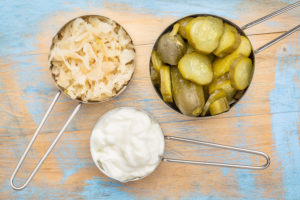For most people the combined use of prebiotics and probiotics to recolonize their gut is a new concept or  method. Yet this combination of prebiotics and probiotics is exactly what is needed.
method. Yet this combination of prebiotics and probiotics is exactly what is needed.
When you examine the research in this area, you’ll see a heavy emphasis on what are called Probiotics.
Probiotics are good bacteria that will help you recolonize your gut flora with the types of bacteria that promote good health.
You can obtain them from supplements, food, or both.
Fermented foods are best because helpful bacteria are used to ferment or breakdown the food into more easily digested components. The top four foods in this category would be:
Yogurt – preferably from goat’s milk as it’s more easily digest than dairy and has a wider range of beneficial bacteria or probiotics.
Kefir – which is goat’s milk and fermented kefir grains.
Sauerkraut – which is fermented cabbage.
Pickles – which can be more types of food than just cucumbers.
And when it comes to Probiotic supplements, there is always the debate about live cultures that have to be refrigerated versus shelf stable cultures. Regardless of which one you choose, they all must pass through the stomach, which presents a problem.
Due to the high acidic nature of the stomach, many of the probiotics don’t survive the journey to the small intestine. This is one reason why you have to take such a large number of active cultures – say 50 billion CFU (colony-forming units).
However, by taking your probiotics with food or dark chocolate, you increase the number CFUs that make it into the small intestine. And the reason why is sugar helps coat them to provide protection from the acids of the stomach environment.
But sugars also feed the bad bacteria that you’re trying to get rid of.
Which brings us to Prebiotics.

Prebiotics and Probiotics Work Better Together
Prebiotics are non-digestible carbohydrates to you, but can be digested by probiotics. They are usually soluble fibers, which aid you in your digestion. When combined with water, they form a gel like substance that can withstand the acidic environment of the stomach. And when they enter the small intestine they become a meal for the bacteria you’re trying to grow.
This means you want prebiotics that will nourish the good bacteria, not the bad bacteria.
And if you properly combine a prebiotic with the correct probiotic, you can then create a positive synergistic effect.
The prebiotic will form a gel-like coating to protect the probiotic through the stomach acids.
This helps more CFUs to make it into the small intestine.
Once in the small intestine, the prebiotic becomes a healthy food source for the probiotic.
This speeds the colonization of your gut microbiome with good bacteria while denying your bad bacteria the food they need.
This helps to quickly reset your gut health so you can enjoy improved wellness.
The Best Prebiotics and Probiotics To Combine
This field is wide open but here is our recommendation on which prebiotics and probiotics is the best combination to rapidly recolonize your gut microbiome.
Inulin – is an excellent Prebiotic. In addition to nourishing the good bacteria it also assists with the digestion and absorption of your food. Inulin plays a significant role in your immune system. And seems to improve heart and bone health, reduce the potential for colon cancer, help protect against inflammatory bowel disease, and aid in preventing constipation.
Source: http://articles.mercola.com/sites/articles/archive/2016/03/07/inulin-health-benefits.aspx
Bacillus Coagulans – a spore-forming probiotic species that can withstand the stomach’s acidic environment so when it enters the intestinal area it can colonize faster. One benefit is that it helps to enhance your immune system, which discourages pathogens through its lactic acid production.
They also aid in cardiovascular health while reducing cancer risks.
In addition to their superior survivability and colonization activities over the more common probiotics like lactobacillus and bifidobacterium, Bacillus Coagulans have been shown to help reduce irritable bowel syndrome, Crohn’s disease, and inflammation associated with both osteoarthritis and rheumatoid arthritis.
Source: http://www.lifeextension.com/magazine/2009/1/optimize-digestive-health/page-01
Leave a Reply
You must be logged in to post a comment.